Methodology of Planning the Course of the Cumulative Cost Curve in Construction Projects
Abstract
1. Introduction
- the shape and course of the S-curve to be determined for construction projects at the planning stage of an investment task;
- the S-curve to be effectively monitored and controlled during the implementation of the task.
1.1. Approach to Cost Management
1.2. Literature Survey
2. Methods
- Step 1: Obtaining data on completed projects;
- Step 2: The development of the Knowledge database;
- Step 3: Processing the collected data;
- Step 4: Development of the S-curve area for correct cost planning;
- Step 5: Testing of the accuracy of the S-curve adjustment.
2.1. Methodology of Research
2.1.1. Step 1: Obtaining Data on Completed Projects
- preliminary reporting that includes verification of the documentation provided by the Investor, with all permits and administrative decisions, as well as the planned budget, and verification of the contracts concluded by the Investor;
- monthly reporting, i.e., constant monitoring of the investment implementation, reliable monitoring of the investment execution status, verification and acceptance of settlements and invoices, analysis of loan tranche disbursement conditions, and also the possible recommendation and implementation of recovery programs;
- final reporting that includes the final financial analysis of the investment implementation along with documentation of obtaining final permits for commissioning the facility for use.
2.1.2. Step 2: The Development of the Knowledge Database
- The obtained data comes from one independent entity that provides Bank Investment Supervision;
- The analyzed reports were prepared according to a uniform method of collecting data concerning construction projects, regardless of the type of building;
- The main analysis was focused on group C of hotel buildings with 106 BIS reports sufficiently representative for cost planning methodology elaboration;
- Both group E (logistic centers) and group G (airport buildings) were excluded from the analysis due to low number of measurements (7 in total);
- Information on the progress of historical construction projects is indisputable and deterministic;
- The construction projects obtained for the analysis include investment tasks that were completed according to plan, as well as projects with changes or delays.
- From the Preliminary Report:
- ∘
- Basic information about the investment, including the type of the implemented object (category A-H), the characteristic technical parameters of the object (e.g., build-up area, total area, usable area, etc.), and the method of executing the investment task (e.g., General Contractor, General Investment Executor, package contractors, etc.);
- ∘
- Information concerning the planned investment implementation schedule;
- ∘
- Information concerning the planned investment budget.
- From Monthly Reports:
- ∘
- Information concerning the actual progress of the investment including the value of works performed in the settlement period, the value of works performed cumulatively, and also work and expenditure advancement;
- ∘
- Information concerning concluded annexes, and also necessity reports that change the scope and/or value of the contract;
- ∘
- Information concerning the occurrence of delays, unforeseen situations in the schedule, uncertainties, or risks.
- From the Final Report:
- ∘
- Information concerning the actual cost and time of completing the investment.
- The budgeted cost of the work scheduled——determined on the basis of the Investor’s work and expenditure schedule for each individual examined period , where is the number of settlement periods; it is expressed in the adopted calculation currency, e.g., PLN;
- The cumulative value of the budgeted cost of the work scheduled——for each single examined period , calculated as the cumulative value obtained by adding the value of the budgeted cost of work scheduled from the analyzed period to the value of budgeted cost of work scheduled from the preceding period according to formula ; it is expressed in the adopted calculation currency, e.g., PLN;
- The actual cost of the work performed——determined on the basis of the Investor’s work and expenditure schedule for each individual examined period , where is the number of settlement periods; it is expressed in the adopted calculation currency, e.g., PLN;
- The cumulative value of the actual cost of the work performed——for each examined individual period , calculated as a cumulative value obtained by adding the value of the actual cost of work performed from the analyzed period to the value of the actual costs of work performed from the preceding period according to formula ; it is expressed in the adopted calculation currency, e.g., PLN;
- The actual percentage advancement of the work performed——calculated as the ratio of the value of the cumulative actual cost of work performed to the total actual cost of the construction project ; it is expressed in percentages;
- The planned percentage advancement of the work scheduled——calculated as the ratio of the cumulative value of the budgeted cost of work scheduled to the total budgeted cost of the construction project ; it is expressed in percentages;
- The actual percentage advancement of the work scheduled——calculated as the ratio of the value of the cumulative actual cost of work performed to the total budgeted cost of the construction project ; it is expressed in percentages.
- Curve 1—presenting the budgeted cost of work scheduled (BCWS) obtained on the basis of the Investor’s work and expenditure schedule, which is developed before the commencement of works;
- Curve 2—showing the actual cost of work performed (ACWP) obtained on the basis of the collected reports of the Bank Investment Supervision and actual values.
- The actual schedule variance——calculated as the difference between the actual duration and the planned duration of the project, and expressed in the adopted unit of time, e.g., months;
- The actual schedule performance indicator——calculated as the ratio of the actual duration of the construction project to the planned duration of the project ; it is a dimensionless quantity;
- The at-completion variance——calculated as the difference between the total actual cost of the construction project and the total budgeted cost of the construction project ; it is expressed in the adopted calculation currency, e.g., PLN;
- The performance indicator of the at-completion variance——calculated as the ratio of the total actual cost of the construction project to the total budgeted cost of the construction project ; it is a dimensionless quantity.
2.1.3. Step 3: Processing the Collected Data
- For each individual examined period for the -th building project, the computation value of cost is determined as:
- ∘
- The ratio of the cumulative value of the budgeted cost of work scheduled for each individual examined period ( to the total budgeted cost of the construction project , i.e., ; it is a dimensionless quantity;
- ∘
- The ratio of the cumulative value of the actual cost of work performed for each examined individual period ) to the total actual cost of the construction project , i.e., ; it is a dimensionless quantity;
- ∘
- The ratio of the cumulative value of the actual cost of work performed for each examined individual period ) to the total budgeted cost of the construction project i.e., ; it is a dimensionless quantity.
- For each individual examined period for the -th building project, the computation value of duration is determined as:
- ∘
- The ratio of the duration for each individual examined period to the total planned duration of the building project ; it is a dimensionless quantity;
- ∘
- The ratio of the duration for each individual examined period to the total actual duration of the building project ; it is a dimensionless quantity.
2.1.4. Step 4: Development of the S-curve Area for Correct Cost Planning
- Analysis of budgeted costs of the work scheduled;
- Analysis of the actual costs of the work performed;
- Analysis of deviations between the budgeted costs of work scheduled and the actual costs of the work performed.
- The area of the S-curve of the budgeted costs;
- The area of the S-curve of the actual costs.
2.1.5. Step 5: Testing of the Accuracy of the S-curve Adjustment
- —there is a weak and insignificant correlative relationship and the model does not sufficiently describe the studied phenomenon;
- —there is an average correlative relationship and the model sufficiently describes the studied phenomenon;
- —there is a strong correlative relationship and the model describes the studied phenomenon well;
- —there is a very strong correlative relationship and the model describes the studied phenomenon very well.
2.2. Data Analysis
2.2.1. Analytical Transformations
2.2.2. Graphical Transformations
- C4—the analysis of the actual progress of work for this project clearly indicates how much the actual state of implementation of the project deviated from that originally assumed. The original budget of the investment task was underestimated. Changes that occurred during the implementation of the project resulted in failure to meet the Investor’s assumed parameters in mid-2016—i.e., the time and cost of implementing the project. The project duration was over 54% longer than that planned, and the final cost of implementation was bigger by 62%;
- C6—the investment included the reconstruction, extension and thermo-modernization of a hotel with the execution of the necessary technical infrastructure and land development. The planned reconstruction aimed to adapt the facility to a new offer, refresh the image, and upgrade the building to the four-star hotel standard. The scope of implementation differs from the other analyzed construction projects.
3. Results
- The S-curves with a high accuracy fit into the 6th degree polynomial with the values of coefficients of determination and correlation coefficients close to one;
- For the area of the S-curve of the planned costs, the 6th degree polynomial in over 95% describes the course of the actual S-curve and it is at a correlation level close to 1;
- For the area of the S-curve of real costs, the 6th degree polynomial in over 97% describes the course of the actual S-curve, and it is at a correlation level close to 1.
- The planned costs resulting from the work and expenditure schedule differ significantly from the actual costs incurred during the execution of the investment. This also applies to the planned time for completing the investment task. The average value of the cost performance efficiency indicator is equal to 1.11 ± 8, which means that the actual cost of implementation is by 2–19% higher than that planned. The average value of the schedule performance efficiency indicator is equal to 1.12 ± 8, which means that the actual implementation time is by 4–20% longer than that planned;
- In traditional cost planning methods, it is assumed that the implementation will take place much faster than in reality, which can be seen in Figure 3 and Figure 7. According to S-curves, the planned work and expenditure advancement is much higher in the first stage of implementation when compared to reality (planned cost curve of the planned work is above the actual performed work curve). According to the obtained 6th degree polynomials, for half of the planned duration of the work, the planned work and expenditure advancement is approx. 24%, while the actual advancement is approx. 22%;
- A comparison of the obtained S-curve areas for the budgeted costs and the actual costs in relation to the actual cost shows that costs are generated at a much faster rate than budgeted in the second stage of implementing works. According to the received 6th degree polynomials, for half of the planned duration of work, the scheduled work and expenditure advancement is approx. 24%, while the actual advancement with the actual duration is approx. 28%;
- Actual costs, after reaching 50% of work and expenditure advancement, are generated at a much faster rate than indicated in the Investor’s work and expenditure schedule until they reach 80%. This is evidenced by the much greater slope of the actual cumulative cost curves towards the time axis.
4. Discussion
Author Contributions
Funding
Conflicts of Interest
References
- Salem, D.; Bakr, A.; El Sayad, Z. Post-construction stages cost management: Sustainable design approach. Alex. Eng. J. 2018, 57, 3429–3435. [Google Scholar] [CrossRef]
- Leśniak, A.; Zima, K. Cost Calculation of Construction Projects Including Sustainability Factors Using the Case Based Reasoning (CBR) Method. Sustainability 2018, 10, 1608. [Google Scholar] [CrossRef]
- Plebankiewicz, E.; Zima, K. Wieczorek Damian Life cycle cost modelling of buildings with consideration of the risk. Arch. Civ. Eng. 2016, 62, 149–166. [Google Scholar]
- Stępień, M. Sustainability as a determinant of cost management in the accounts of a manufacturing Industry. Glob. J. Environ. Sci. Manag. 2019, 5, 151–159. [Google Scholar]
- Mesároš, P.; Smetanková, J.; Krajníková, K.; Mandičák, T. Cost Management of Sustainable Buildings Trough Bim Technology. Int. Multidiscip. Sci. GeoConf. SGEM 2018, 18. Available online: https://search.proquest.com/openview/2970198816e7c90a8018273640c03e3f/1?pq-origsite=gscholar&cbl=1536338 (accessed on 17 March 2020).
- Mingus, N. Project Management; Alpha Publishing: Dubai, The United Arab Emirates, 2001; ISBN 0028642236. [Google Scholar]
- Kerzner, H. Project Management: A Systems Approach to Planning, Scheduling, and Controlling; John Wiley&Sons, Inc.: New York, NY, USA, 2003. [Google Scholar]
- Połoński, M. Management of Construction Investment Process; Wydawnictwo SGGW: Warszawa, Poland, 2018; ISBN 9788375830873. [Google Scholar]
- Zavadskas, E.K.; Turskis, Z.; Tamošaitienė, J. Risk assessment of construction projects. J. Civ. Eng. Manag. 2010, 16, 33–46. [Google Scholar] [CrossRef]
- Leśniak, A.; Kubek, D.; Plebankiewicz, E.; Zima, K.; Belniak, S. Fuzzy AHP Application for Supporting Contractors’ Bidding Decision. Symmetry 2018, 10, 642. [Google Scholar] [CrossRef]
- Kumar, V.S.S.; Hanna, A.S.; Adams, T. Assessment of working capital requirements by fuzzy set theory. Eng. Constr. Archit. Manag. 2000, 7, 93–103. [Google Scholar] [CrossRef]
- Lam, K.C.; So, A.T.P.; Hu, T.; Ng, T.; Yuen, R.K.K.; Lo, S.M.; Cheung, S.O.; Yang, H. An integration of the fuzzy reasoning technique and the fuzzy optimization method in construction project management decision-making. Constr. Manag. Econ. 2001, 19, 63–76. [Google Scholar] [CrossRef]
- Cheng, M.-Y.; Roy, A.F.V. Evolutionary fuzzy decision model for cash flow prediction using time-dependent support vector machines. Int. J. Proj. Manag. 2011, 29, 56–65. [Google Scholar] [CrossRef]
- Cheng, M.-Y.; Tsai, H.-C.; Liu, C.-L. Artificial intelligence approaches to achieve strategic control over project cash flows. Autom. Constr. 2009, 18, 386–393. [Google Scholar] [CrossRef]
- Plebankiewicz, E.; Zima, K.; Wieczorek, D. Quantification of the risk addition in life cycle cost of a building object. Tech. Trans. 2017, 5, 35–45. [Google Scholar]
- Kasprowicz, T. Quantitative Assessment of Construction Risk. Arch. Civ. Eng. 2017, 63, 55–66. [Google Scholar] [CrossRef]
- Kasprowicz, T. Quantitative Identification of Construction Risk. Arch. Civ. Eng. 2017, 63, 63–75. [Google Scholar] [CrossRef][Green Version]
- Project Management Institute. A Guide to the Project Management Body of Knowledge (PMBOK Guide), 6th ed.; Project Management Institute (PMI): Newtown Square, PA, USA, 2017; ISBN 9781935589679. [Google Scholar]
- IPMA. IPMA Individual Competence Baseline; IPMA: Amsterdam, The Netherlands, 2015.
- Chin-Keng, T.; Shahdan, N. The Application of Earned Value Management (EVM) in Construction Project Management. J. Technol. Manag. Bus. 2015. Available online: https://www.semanticscholar.org/paper/The-Application-of-Earned-Value-Management-(EVM)-in-Keng-Shahdan/4a282f7dac42a66f4c551aba3648fdcd1d30d9a6 (accessed on 17 March 2020).
- Vandevoorde, S.; Vanhoucke, M. A comparison of different project duration forecasting methods using earned value metrics. Int. J. Proj. Manag. 2006, 24, 289–302. [Google Scholar] [CrossRef]
- Kwon, O.; Kim, S.; Paek, J.; Eom, S.-J. Application of Earned Value in the Korean Construction Industry. J. Asian Archit. Build. Eng. 2008, 7, 69–76. [Google Scholar] [CrossRef][Green Version]
- Khamidi, M.F.; Ali, W.; Idrus, A. Application of Earned Value Management System on an Infrastructure Project: A Malaysian Case Study. Int. Conf. Manag. Sci. Eng. 2011, 8, 1–5. [Google Scholar]
- Połoński, M.; Komendarek, P. Earned value method for operational cost control of civil structure. Quantit. Meth. Econ. 2011, 12, 279–290. [Google Scholar]
- Amiri, M.; Ardeshir, A.; Fazel Zarandi, M.H. Risk-based Analysis of Construction Accidents in Iran During 2007-2011-Meta Analyze Study. Iran. J. Public Health 2014, 43, 507–522. [Google Scholar]
- Czemplik, A. Application of earned value method to progress control of construction projects. Procedia Eng. 2014, 91, 424–428. [Google Scholar] [CrossRef]
- Przywara, D.; Rak, A. The time-cost analysis of schedule monitoring using the earned value method. Tech. Trans. 2017, 5, 57–66. [Google Scholar]
- Dziadosz, A.; Kapliński, O.; Rejment, M. Usefulness and fields of the application of the Earned Value Management in the implementation of construction projects. Bud. Archit. 2014, 13, 357–364. [Google Scholar]
- Czarnigowska, A. Earned value method as a tool for project control. Bud. Archit. 2008, 3, 15–32. [Google Scholar]
- Ziółkowska, A.; Połoński, M. Application of the EVM method and its extensions in the implementation of construction objects. Eng. Struct. Technol. 2015, 7, 189–196. [Google Scholar] [CrossRef]
- Khamooshi, H.; Golafshani, H. EDM: Earned Duration Management, a new approach to schedule performance management and measurement. Int. J. Proj. Manag. 2014, 32, 1019–1041. [Google Scholar] [CrossRef]
- De Andrade, P.A.; Martens, A.; Vanhoucke, M. Using real project schedule data to compare earned schedule and earned duration management project time forecasting capabilities. Autom. Constr. 2019, 99, 68–78. [Google Scholar] [CrossRef]
- Cristóbal, J.R.S. The S-curve envelope as a tool for monitoring and control of projects. Procedia Comput. Sci. 2017, 121, 756–761. [Google Scholar] [CrossRef]
- Al-Jibouri, S.H. Monitoring systems and their effectiveness for project cost control in construction. Int. J. Proj. Manag. 2003, 21, 145–154. [Google Scholar] [CrossRef]
- Gebrehiwet, T.; Luo, H. Analysis of Delay Impact on Construction Project Based on RII and Correlation Coefficient: Empirical Study. Procedia Eng. 2017, 196, 366–374. [Google Scholar] [CrossRef]
- Gardezi, S.S.S.; Manarvi, I.A.; Gardezi, S.J.S. Time Extension Factors in Construction Industry of Pakistan. Procedia Eng. 2014, 77, 196–204. [Google Scholar] [CrossRef]
- Makesh, S.; Mathivanan, M. Analysis on causes of delay in building construction. Int. J. Innov. Technol. Explor. Eng. 2019, 8, 335–341. [Google Scholar]
- Rachid, Z.; Toufik, B.; Mohammed, B. Causes of schedule delays in construction projects in Algeria. Int. J. Constr. Manag. 2019, 19, 371–381. [Google Scholar] [CrossRef]
- Kern, A.P.; Formoso, C.T. A model for integrating cost management and production planning and control in construction. J. Financ. Manag. Prop. Constr. 2006, 11, 75–90. [Google Scholar] [CrossRef]
- Wang, S.-H.; Wanh, W.-C.; Hsu, P.-Y.; Chen, C.-H.; Wand, K.-C. Establishing engineering S-curves to evaluate supervision engineer allocations for highway construction projects. J. Civ. Eng. Manag. 2016, 22, 890–902. [Google Scholar] [CrossRef]
- Chao, L.-C.; Chien, C.-F. Estimating Project S-Curves Using Polynomial Function and Neural Networks. J. Constr. Eng. Manag. 2009, 135, 169–177. [Google Scholar] [CrossRef]
- Chao, L.-C.; Chien, C.-F. A Model for Updating Project S-curve by Using Neural Networks and Matching Progress. Autom. Constr. 2010, 19, 84–91. [Google Scholar] [CrossRef]
- Hsieh, T.Y.; Wang, M.H.L.; Chen, C.W.; Chen, C.Y.; Yu, S.E.; Yang, H.C.; Chen, T.H. A new viewpoint of s-curve regression model and its application to construction management. Int. J. Artif. Intell. Tools 2006, 15, 131–142. [Google Scholar] [CrossRef]
- Hsieh, T.-Y.; Wang, L.; Hsiao, M.; Chen, C.-W. A Case Study of S-Curve Regression Method to Project Control of Construction Management via T-S Fuzzy Model. J. Mar. Sci. Technol. 2004, 12, 209–216. [Google Scholar]
- Kim, B.C.; Reinschmidt, K. An S-curve Bayesian model for forecasting probability distributions on project duration and cost at completion. In Proceedings of the CME 2007 Conference—Construction Management and Economics: "Past, Present and Future", Reading, UK, 16–18 July 2007; pp. 1449–1459. [Google Scholar]
- Cheng, Y.M.; Yu, C.H.; Wang, H.T. Short-interval dynamic forecasting for actual S-curve in the construction phase. J. Constr. Eng. Manag. 2011, 137, 933–941. [Google Scholar] [CrossRef]
- Chao, L.-C.; Chen, H.-T. Predicting project progress via estimation of S-curve’s key geometric feature values. Autom. Constr. 2015, 57, 33–41. [Google Scholar] [CrossRef]
- Kozień, E. Application of approximation technique to on-line updating of the actual cost curve in the earned value method. Czas. Tech. 2017, 9, 181–195. [Google Scholar]
- Barraza, G.A.; Back, W.E.; Mata, F. Probabilistic Forecasting of Project Performance Using Stochastic S Curves. J. Constr. Eng. Manag. 2004, 130, 25–32. [Google Scholar] [CrossRef]
- Yao, J.-S.; Chen, M.-S.; Lu, H.-F. A fuzzy stochastic single-period model for cash management. Eur. J. Oper. Res. 2006, 170, 72–90. [Google Scholar] [CrossRef]
- Mohagheghi, V.; Meysam Mousavi, S.; Vahdani, B. An Assessment Method for Project Cash Flow under Interval-Valued Fuzzy Environment. J. Optim. Ind. Eng. 2017, 22, 79–80. [Google Scholar]
- Maravas, A.; Pantouvakis, J.-P. Project cash flow analysis in the presence of uncertainty in activity duration and cost. Int. J. Proj. Manag. 2012, 30, 374–384. [Google Scholar] [CrossRef]
- Konior, J. Monitoring of Construction Projects Feasibility by Bank Investment Supervision Approach. Civ. Eng. Archit. 2019, 7, 31–35. [Google Scholar] [CrossRef]
- Konior, J. Feasibility Study of Construction Project in Compliance with Bank Investment Supervision Requirements. J. Civ. Eng. Archit. 2018, 12, 831–837. [Google Scholar] [CrossRef][Green Version]
- Bauer-Celny, A.; Konior, J.; Szóstak, M. Initial, Monthly, Close-out Reporting of Bank Investment Supervision; PM Group Polska sp. z o.o. 2006–2015 and 3EPCM sp. z o.o. 2016–2019: Wrocław, Poland, 2006. [Google Scholar]
- Government Regulation of 30 December 1999 of the Polish Classification of Construction Objects as amended (Law Gazette, No. 112, it. 1316 and No. 18, it. 170) 1999. Available online: http://prawo.sejm.gov.pl/isap.nsf/DocDetails.xsp?id=WDU19991121316 (accessed on 17 March 2020).
- Becla, A.; Zielińska, A. Elements of Statistics and Quantitative Methods; I-BIS: Wrocław, Poland, 2003. (In Polish) [Google Scholar]
- Stanisz, A. AccessibleSstatistics Course with Application STATISTICA PL on Examples ofMmedicine. Volume 1. Basic Statistics; StatSoft Polska Sp. z o.o.: Kraków, Poland, 2006. [Google Scholar]
- Banki, M.T.; Esmaeeli, B. Using historical data for forecasting S-curves at construction industry. In Proceedings of the 2008 IEEE International Conference on Industrial Engineering and Engineering Management, Singapore, 8–11 December 2008; IEEE: Piscataway Township, NJ, USA, 2008; pp. 282–286. [Google Scholar]

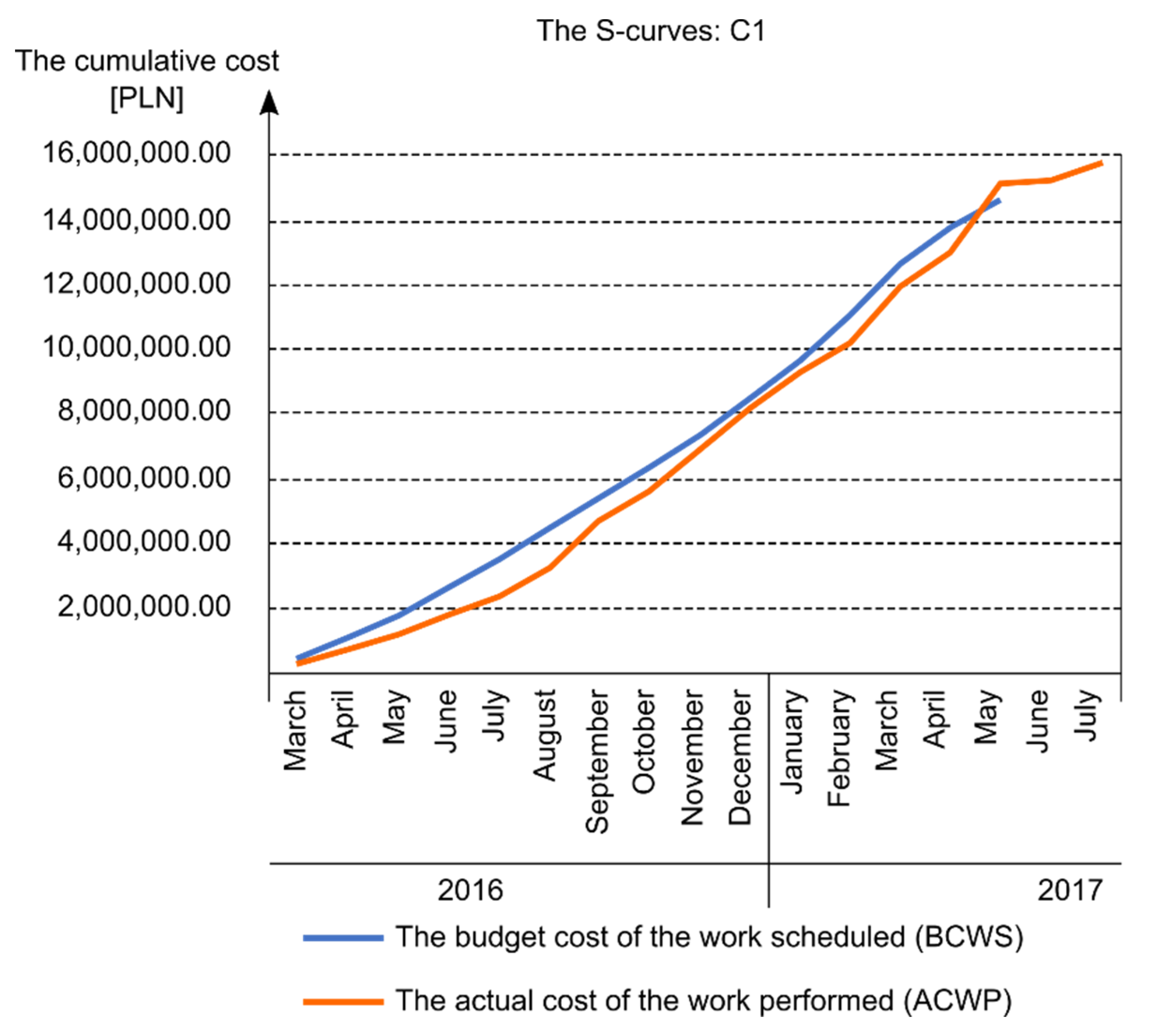
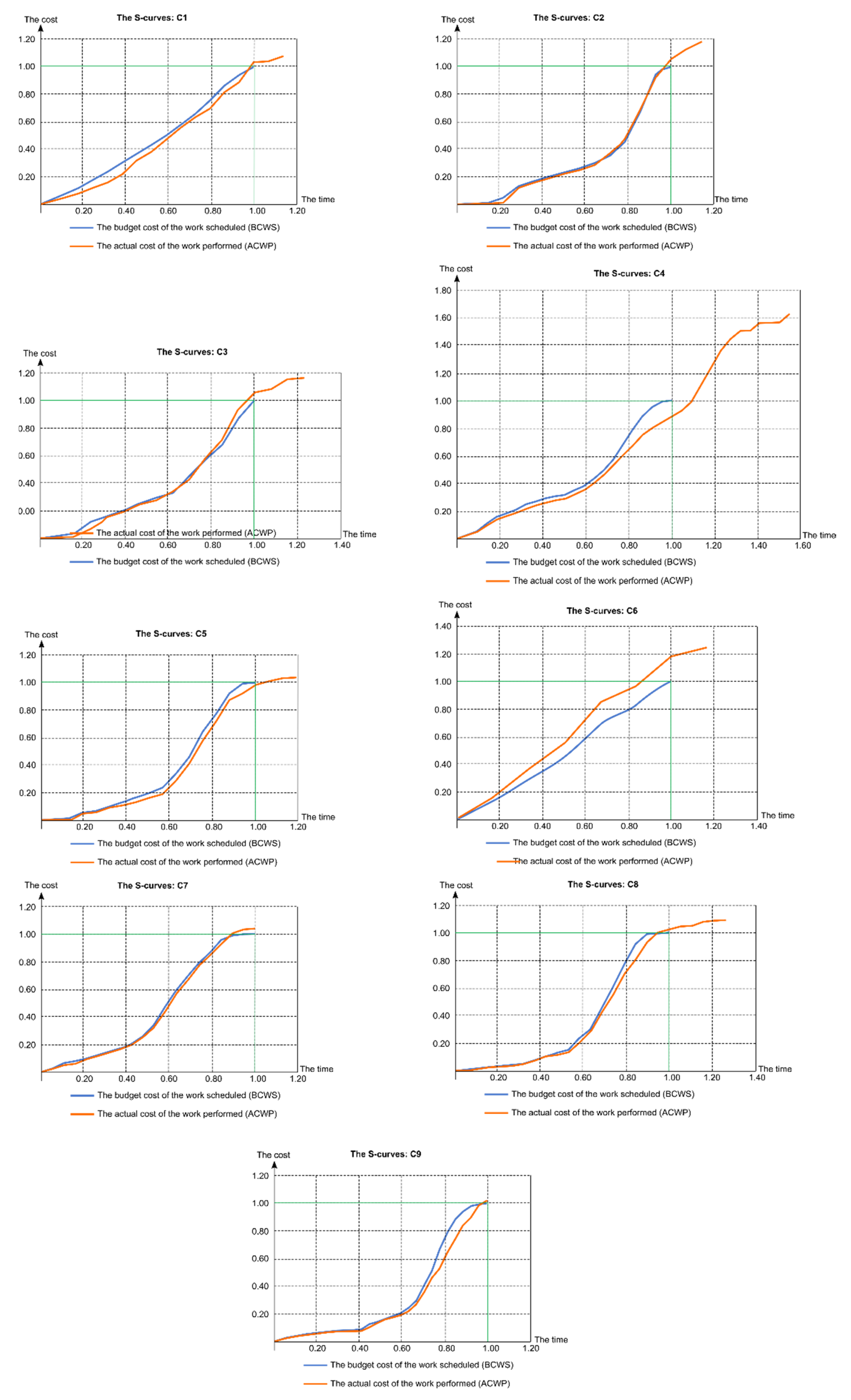


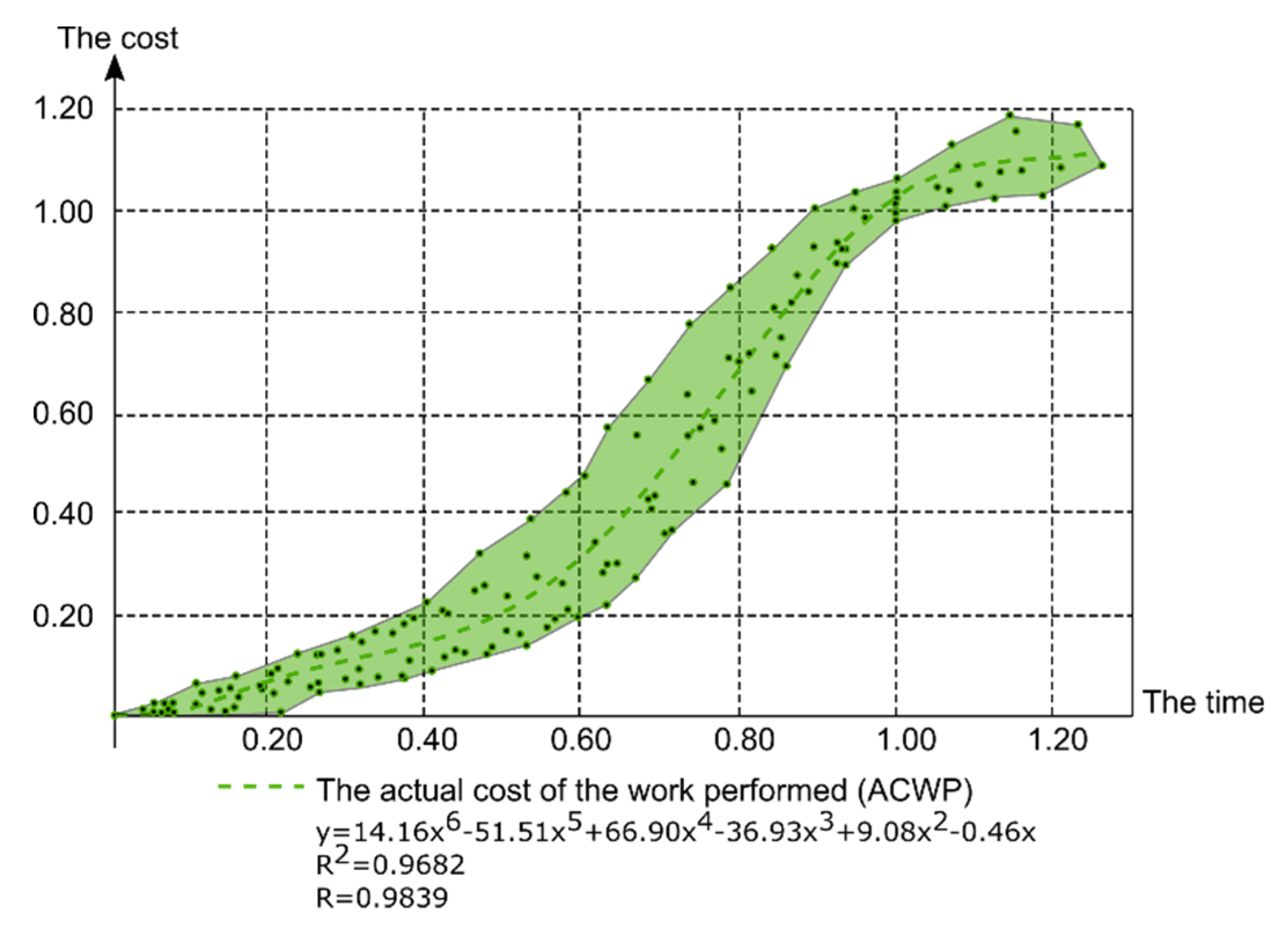
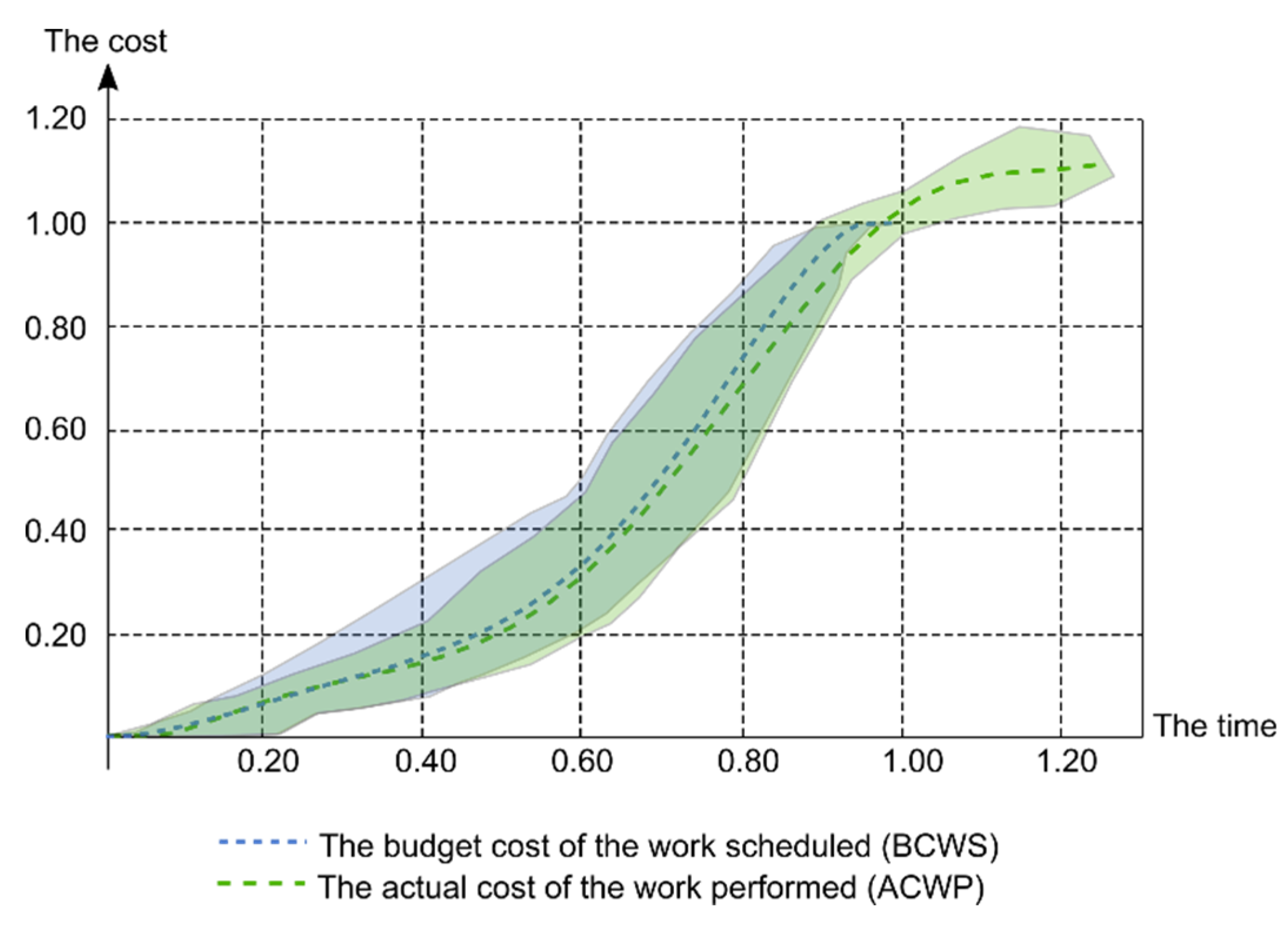
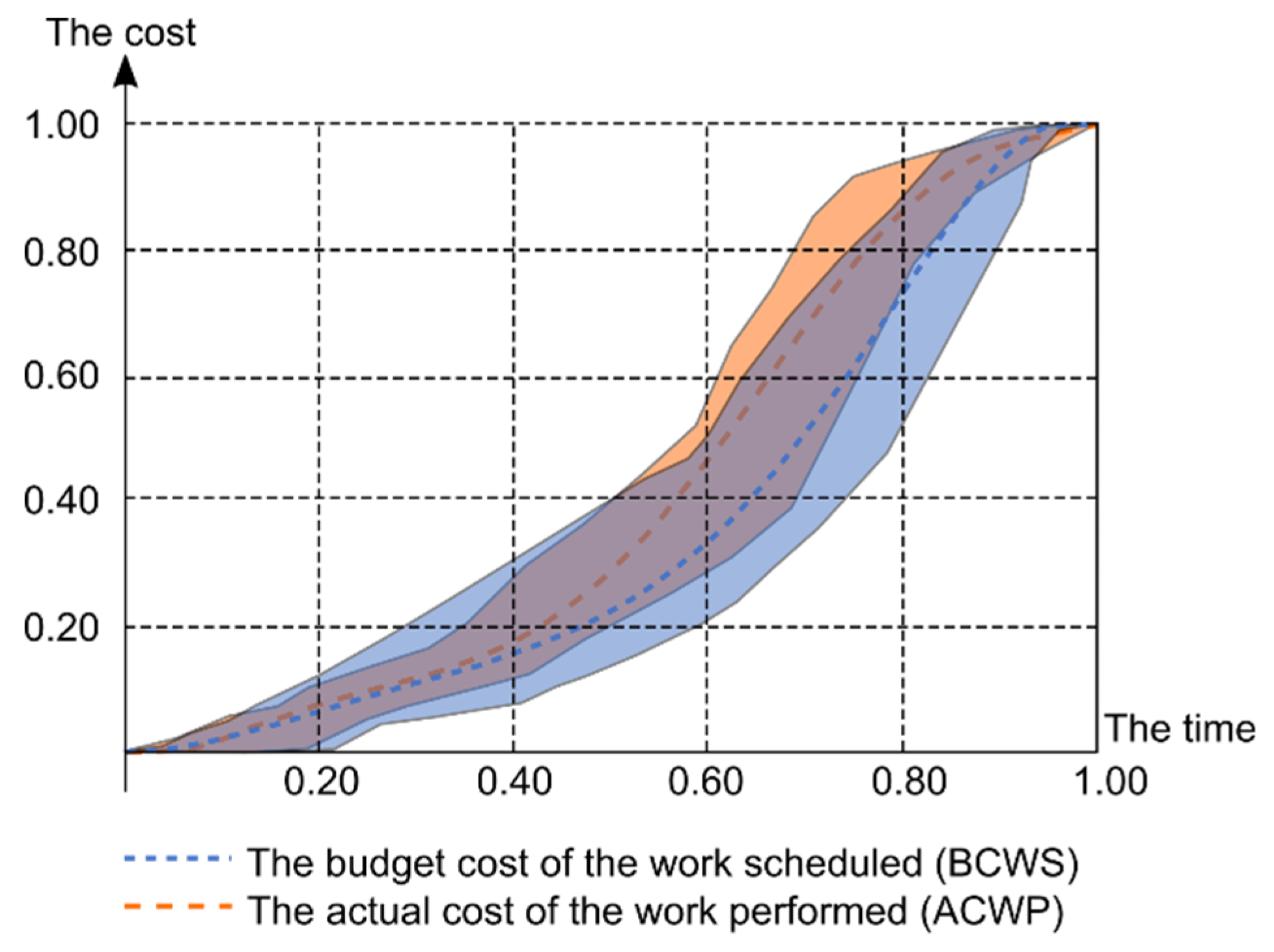
| Category | Specification | Symbol according to the Polish Classification of Construction Objects (PCCO) | Number of Construction Projects | Number of Reports |
|---|---|---|---|---|
| A | Residential buildings | 1130 | 11 | 163 |
| B | Office buildings | 1220 | 3 | 50 |
| C | Hotel buildings | 1211 | 9 | 106 |
| D | Commercial and service buildings | 1230 | 9 | 132 |
| E | Logistic centers | 1252 | 2 | 4 |
| F | Health centers | 1264 | 1 | 12 |
| G | Production plants | 1251 | 1 | 36 |
| H | Airport buildings | 1241 | 1 | 3 |
| 37 | 506 |
| No. | Period | Budgeted Cost of Work Scheduled | Cumulative Value of the Budgeted Cost of Work Scheduled | Actual Cost of Work Performed | Cumulative Value of the Actual Cost of Work Performed | Actual Percentage Advancement of Work Performed | Planned Percentage Advancement of Work Scheduled | Actual Percentage Advancement of Work Scheduled |
|---|---|---|---|---|---|---|---|---|
| (1) | (2) | (3) | (4) | (5) | (6) | (7) | (8) | (9) |
| [PLN] | [PLN] | [PLN] | [PLN] | [%] | [%] | [%] | ||
| 1 | Mar-16 | 414,590.36 | 414,590.36 | 300,000.00 | 300,000.00 | 1.90 | 2.83 | 2.04 |
| 2 | Apr-16 | 682,197.42 | 1,096,787.78 | 420,241.18 | 720,241.18 | 4.56 | 7.48 | 4.91 |
| 3 | May-16 | 700,272.63 | 1,797,060.41 | 500,000.00 | 1,220,241.18 | 7.72 | 12.25 | 8.32 |
| 4 | Jun-16 | 852,111.92 | 2,649,172.33 | 580,000.00 | 1,800,241.18 | 11.39 | 18.06 | 12.27 |
| 5 | Jul-16 | 892,234.65 | 3,541,406.98 | 600,000.00 | 2,400,241.18 | 15.18 | 24.14 | 16.36 |
| 6 | Aug-16 | 934,722.02 | 4,476,129.00 | 850,000.00 | 3,250,241.18 | 20.56 | 30.51 | 22.15 |
| 7 | Sep-16 | 934,722.02 | 5,410,851.02 | 1,457,298.79 | 4,707,539.97 | 29.77 | 36.88 | 32.09 |
| 8 | Oct-16 | 952,481.40 | 6,363,332.42 | 961,383.08 | 5,668,923.05 | 35.85 | 43.38 | 38.64 |
| 9 | Nov-16 | 1,000,634.49 | 7,363,966.91 | 1,270,495.12 | 6,939,418.17 | 43.89 | 50.20 | 47.30 |
| 10 | Dec-16 | 1,102,728.57 | 8,466,695.48 | 1,262,446.98 | 8,201,865.15 | 51.87 | 57.71 | 55.91 |
| 11 | Jan-17 | 1,238,022.53 | 9,704,718.01 | 1,122,909.50 | 9,324,774.65 | 58.97 | 66.15 | 63.56 |
| 12 | Feb-17 | 1,393,937.34 | 11,098,655.35 | 894,722.74 | 10,219,497.39 | 64.63 | 75.65 | 69.66 |
| 13 | Mar-17 | 1,569,875.78 | 12,668,531.13 | 1,758,046.71 | 11,977,544.10 | 75.75 | 86.35 | 81.64 |
| 14 | Apr-17 | 1,164,403.35 | 13,832,934.48 | 1,071,393.40 | 13,048,937.50 | 82.53 | 94.29 | 88.95 |
| 15 | May-17 | 837,571.54 | 14,670,506.02 | 2,099,607.39 | 15,148,544.89 | 95.80 | 100.00 | 103.26 |
| 16 | Jun-17 | 0.00 | 14,670,506.02 | 101,379.48 | 15,249,924.37 | 96.45 | 100.00 | 103.95 |
| 17 | Jul-17 | 0.00 | 14,670,506.02 | 561,953.48 | 15,811,877.85 | 100.00 | 100.00 | 107.78 |
| Type of Budget | Duration | Cost of Building Investment | Actual Schedule Variance | At-completion Variance | Actual Schedule Performance Indicator | Performance Indicator of the At-completion Variance |
|---|---|---|---|---|---|---|
| / | / | |||||
| (1) | (2) | (3) | (4) | (5) | (6) | (7) |
| [mos] | [PLN] | [mos] | [PLN] | |||
| Cost of construction works—initial | 15 | 14,670,506.02 | ||||
| Cost of construction—actual | 17 | 15,811,877.85 | 2 | 1,141,371.83 | 1.13 | 1.08 |
| No. | Period | Cumulative Value of the Budgeted Cost of Work Scheduled | Calculated Value of Cost | Calculated Value of Duration | Cumulative Value of the Actual Cost of Work Performed | Calculated Value of Cost | Calculated Value of Duration | Calculated Value of Cost | Calculated Value of Duration |
|---|---|---|---|---|---|---|---|---|---|
| (1) | (2) | (3) | (4) | (5) | (6) | (7) | (8) | (10) | (11) |
| [PLN] | [PLN] | ||||||||
| 1 | Mar-16 | 414,590.36 | 0.07 | 0.03 | 300,000.00 | 0.06 | 0.02 | 0.07 | 0.02 |
| 2 | Apr-16 | 1,096,787.78 | 0.13 | 0.07 | 720,241.18 | 0.12 | 0.05 | 0.13 | 0.05 |
| 3 | May-16 | 1,797,060.41 | 0.20 | 0.12 | 1,220,241.18 | 0.18 | 0.08 | 0.20 | 0.08 |
| 4 | Jun-16 | 2,649,172.33 | 0.27 | 0.18 | 1,800,241.18 | 0.24 | 0.11 | 0.27 | 0.12 |
| 5 | Jul-16 | 3,541,406.98 | 0.33 | 0.24 | 2,400,241.18 | 0.29 | 0.15 | 0.33 | 0.16 |
| 6 | Aug-16 | 4,476,129.00 | 0.40 | 0.31 | 3,250,241.18 | 0.35 | 0.21 | 0.40 | 0.22 |
| 7 | Sep-16 | 5,410,851.02 | 0.47 | 0.37 | 4,707,539.97 | 0.41 | 0.30 | 0.47 | 0.32 |
| 8 | Oct-16 | 6,363,332.42 | 0.53 | 0.43 | 5,668,923.05 | 0.47 | 0.36 | 0.53 | 0.39 |
| 9 | Nov-16 | 7,363,966.91 | 0.60 | 0.50 | 6,939,418.17 | 0.53 | 0.44 | 0.60 | 0.47 |
| 10 | Dec-16 | 8,466,695.48 | 0.67 | 0.58 | 8,201,865.15 | 0.59 | 0.52 | 0.67 | 0.56 |
| 11 | Jan-17 | 9,704,718.01 | 0.73 | 0.66 | 9,324,774.65 | 0.65 | 0.59 | 0.73 | 0.64 |
| 12 | Feb-17 | 11,098,655.35 | 0.80 | 0.76 | 10,219,497.39 | 0.71 | 0.65 | 0.80 | 0.70 |
| 13 | Mar-17 | 12,668,531.13 | 0.87 | 0.86 | 11,977,544.10 | 0.76 | 0.76 | 0.87 | 0.82 |
| 14 | Apr-17 | 13,832,934.48 | 0.93 | 0.94 | 13,048,937.50 | 0.82 | 0.83 | 0.93 | 0.89 |
| 15 | May-17 | 14,670,506.02 | 1.00 | 1.00 | 15,148,544.89 | 0.88 | 0.96 | 1.00 | 1.03 |
| 16 | Jun-17 | 15,249,924.37 | 0.94 | 0.96 | 1.07 | 1.04 | |||
| 17 | Jul-17 | 15,811,877.85 | 1.00 | 1.00 | 1.13 | 1.08 |
| Building Investment | Planned Duration | Actual Duration | Budgeted Cost of Work Scheduled | Actual Cost of Work Performed | Actual Schedule Performance Indicator | Performance Indicator of the At-completion Variance |
|---|---|---|---|---|---|---|
| (1) | (2) | (3) | (4) | (5) | (6) | (7) |
| [mos] | [mos] | [PLN] | [PLN] | |||
| C1 | 15 | 17 | 14,670,506.00 | 15,811,877.85 | 1.13 | 1.08 |
| C2 | 14 | 16 | 18,772,396.15 | 22,234,333.17 | 1.18 | 1.14 |
| C3 | 13 | 16 | 19,397,717.04 | 22,687,867.32 | 1.17 | 1.23 |
| C4 | 22 | 34 | 36,111,145.90 | 58,646,384.75 | 1.62 | 1.55 |
| C5 | 16 | 19 | 27,548,670.90 | 28,453,408.93 | 1.03 | 1.19 |
| C6 | 6 | 7 | 15,786,766.99 | 19,706,536.28 | 1.24 | 1.17 |
| C7 | 19 | 19 | 48,739,724.74 | 50,467,311.37 | 1.03 | 1.00 |
| C8 | 22 | 24 | 36,608,045.94 | 39,958,136.38 | 1.09 | 1.09 |
| C9 | 27 | 27 | 42,023,393.72 | 42,549,046.61 | 1.01 | 1.00 |
© 2020 by the authors. Licensee MDPI, Basel, Switzerland. This article is an open access article distributed under the terms and conditions of the Creative Commons Attribution (CC BY) license (http://creativecommons.org/licenses/by/4.0/).
Share and Cite
Konior, J.; Szóstak, M. Methodology of Planning the Course of the Cumulative Cost Curve in Construction Projects. Sustainability 2020, 12, 2347. https://doi.org/10.3390/su12062347
Konior J, Szóstak M. Methodology of Planning the Course of the Cumulative Cost Curve in Construction Projects. Sustainability. 2020; 12(6):2347. https://doi.org/10.3390/su12062347
Chicago/Turabian StyleKonior, Jarosław, and Mariusz Szóstak. 2020. "Methodology of Planning the Course of the Cumulative Cost Curve in Construction Projects" Sustainability 12, no. 6: 2347. https://doi.org/10.3390/su12062347
APA StyleKonior, J., & Szóstak, M. (2020). Methodology of Planning the Course of the Cumulative Cost Curve in Construction Projects. Sustainability, 12(6), 2347. https://doi.org/10.3390/su12062347






